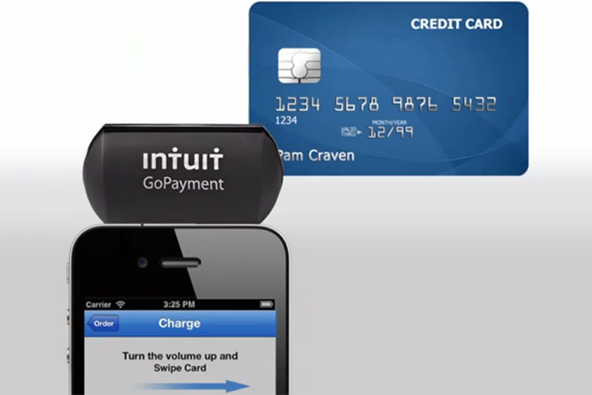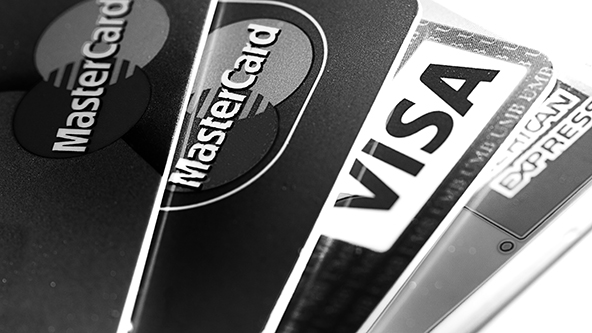Pricing Disclosures, Straightforwardness and Intuit GoPayment vs. Square

Intuit has integrated its payment acceptance service for brick-and-mortar retailers with GoPayment, its Square-like mobile payments service, the company is telling us in a press release. The QuickBooks Point of Sale 2013, as the latest edition of Intuit’s POS service is called, is of course offering all other features that users of its previous versions would expect of it and I have little doubt that they will love the update.
But how does Intuit’s QuickBooks-connected GoPayment service compare to Square’s Register, its emerging competitor? Reading through what Intuit’s executives have been telling the media, one may get the impression that none of their rivals offers anything that comes anywhere close to their product’s capabilities. The reality, however, is quite different. Whereas QuickBooks is without a doubt the most powerful accounting software currently available to small businesses at a reasonable price, Square Register has been closing the gap quickly, while offering a much more straightforward pricing to its users. And, on balance, Square may be the better choice.
The Features
So the news is that Intuit’s QuickBooks Point of Sale can now be synced with the company’s GoPayment mobile payments offering, so that whether a merchant accepts a payment through the POS register or a mobile phone, the transaction is recorded into their QuickBooks account. As Intuit says, merchants using the company’s software can now accept “credit cards in the aisle or on the go at street fairs and trade shows using GoPayment on the most popular smartphones and tablets.” And you can see how being able to check customers out in the aisles of your store could eliminate the lines at the registers at peak hours. Moreover, you can’t really take your POS terminal with you to a trade show, so these are all legitimate points.
But how does Intuit’s offering compare to Square Register?
Well, to begin with, Square Register doesn’t come with a full-fledged accounting software built into it, so Intuit has a clear advantage here. However, Square’s offering does let you import your inventory and automatically keeps track of your sales, as well as of your customers. Moreover, the Register allows users to monitor transactions in real time through its analytics feature. It’s a pretty powerful solution and it’s free, while the basic Intuit version costs $1,099.95. Then there is the pricing issue.
The Pricing
We’ve done a detailed comparison between Square’s and GoPayment’s pricing models before and the biggest difference that we discovered was that Square’s fees were much more clearly disclosed, while Intuit seems to have gone out of its way to hide the real cost of its service. I’m not going to go over the whole comparison again here, just take a look at what we already wrote for details. I will just say that much of GoPayment’s most important pricing details are hidden in the fine print of the disclosures underneath the main pricing table, which you can see here. Square, on the other hand, is as straightforward as can be.
Intuit’s approach to pricing is, regrettably, the same with QuickBooks Point of Sale 2013. Actually, Intuit has this time literally hidden some of the pricing disclosures of its POS solution. I will go into details in a moment, but first let me mention that the regular GoPayment pricing has been superseded by the regular Intuit payment processing pricing. Now on to the details. Intuit tells us that the rates for Visa, MasterCard and Discover are 1.64 percent for swiped and 2.75 percent for key-entered transactions. But there is more to it and the details can be seen after you click on the “Important disclosures” link underneath the pricing table. There is a lot to be learned there, including that:
- Card-swiped rate applies to qualified swiped Visa/MC/Discover network transactions.
- All Visa/MC/Discover network transactions that do not meet the requirements for card-swiped and or key entered rates will be charged a non-qualified rate of 3.94%.
- A per-authorization fee of $0.34 will be charged for “Non-Qualified” transactions.
Now, you may ask, what is a qualified transaction? To the uninitiated, these are payments made with rewards and other special types of cards and they will not be processed at the “card-swiped” rate, even if they are actually successfully swiped through the reader. Instead, they will be processed at the higher “key-entered” rate and will be assessed an additional per-authorization fee of $0.34 for good measure. Now I ask you: do you think Intuit’s pricing is clear and straightforward?
The Takeaway
Intuit’s payment processing service has many things going for it and I can testify that merchants do love using it and often ask whether our own platform is compatible with it. However, Intuit can and should be much more straightforward with its pricing. Yes, setting up a pricing model that is at the same time easy to sell and simple to explain to merchants is not an easy task. But once a company develops a pricing model, it owes it to its existing and prospective clients to clearly explain all of its details. Intuit has not done so.
Image credit: YouTube / Intuit.



Square Register is so slick, it’s far better than anything else I’ve seen as far as cash registers go. And on top of that it’s free, so why would anyone choose Intuit.
It’s amazing to me how a company like Intuit will still be doing such cheap tricks with its pricing. Customers will find out the real cost as soon as the first month of service and if they don’t see what they thought they signed up for, they would be pissed and would let everyone else know. This is a PR disaster waiting to happen.
You shouldn’t fall too deeply in love with Square. They are holding my money for no good reason and they do not answer the phone and do not reply to emails. Customer service is non-existent.
This is what Intuit is doing to me right now! I am getting real pissed! They will not release my $5,100 so I can continue to do business.
Square are great to work with for small amounts of money, but not for larger sales and overall volumes. They are holding a large amount of my money and are asking me to provide a lot of information that I don’t have. I can’t talk with anyone when I call them and their emails never address the issue. At this point I’m afraid that I may lose my money. So whatever you may say about how straightforward their pricing is, for me it was a huge mistake to sign up with Square.
I have been using Square pretty much since they got started back in 2010 and have never had any issues with them. They do exactly what their T&C say they do. I get my money on the following day and have never had to deal with any holds.
You’ve been lucky so far but I wouldn’t count on it in the future. The other commenters who said that Square has absolutely no customer service are right. I am still waiting for more than $15,000 worth of swiped transactions to be deposited into my bank account, but it isn’t happening even though my customers’ credit cards have been charged already. I keep calling Square, bur there is no one there to respond. So I strongly recommend that small businesses stay away from Square and use a traditional credit card processor, like Intuit.
Jamie, the problem is that most Square users would not qualify for a traditional merchant account, whether with Intuit or some other credit card processor. They are just too small, usually 1- or 2-person operations and the processors have purposely made it impossible for them to qualify, because they are not profitable. So the alternative is not Intuit, but another Square-like service, like PayPal Here for example.
Square looks good and there is all this hype around it, but it is a totally different experience when you start using it. As others have pointed out here, they can easily hold your money and their customer service is atrocious. They haven’t even bothered to create a BBB account.
That is a good move on the part of Intuit. They are closing the loop by integrating their POS software with GoPayment. And of course, they would prevent everyone else from doing it by keeping GoPayment incompatible with other types of POS software.
I am a loyal QuickBooks and Square user and I wish that there was a way to integrate them. I could use GoPayment instead but I’ve never had any issues with Square and their pricing is better.
I’m a Square user, but I may try GoPayment just to see how it compares on price. There is no monthly fee so there is nothing to lose.
I looked at Intuit’s GoPayment web site (http://payments.intuit.com/products/basic-payment-solutions/mobile-credit-card-processing.jsp), opened the “Important disclosures” link, and found no mention of per-transaction fees. So I asked an online rep if there are per-transaction fees for non-qualified cards or in any other circumstances and got a “no sir”. Is this post out of date or am I missing something?
Hello Russ,
It would be easier if you just followed the links in my article, but the non-qualified rate is clearly listed in the disclosure to which you are referring. Just look down in the list and you will see the following:
“10 Key-Entered Rate will be charged on all qualified manually keyed Visa/MC/Discover Network transactions that have verified addresses. All Visa/MC/Discover network transactions that do not meet the requirements for card-swiped and or key entered rates will be charged a non-qualified rate of 3.70%.”
My question referred to the per-transaction fee, not the rate. Your quote “A per-authorization fee of $0.34 will be charged for ?Ç£Non-Qualified?Ç¥ transactions” appears in neither the page you linked to nor the one I linked to. It appears that this fee is no longer charged.
Yes, it is still right where I indicated in my post. Here is the link again; http://payments.intuit.com/products/quickbooks-payment-solutions/point-of-sale-solutions.jsp. Click on the “Pricing” tab. Scroll down and click on the “Important disclosures” link. Scroll down and you will see the following:
“7 A per-authorization fee of $0.34 will be charged for “Non-Qualified” transactions.”
But the fact that you are having so much trouble finding this clearly indicates how well it is hidden.
I see the problem. We are talking about two different products. In your post you say “I will just say that much of GoPayment?ÇÖs most important pricing details are hidden in the fine print of the disclosures underneath the main pricing table, which you can see here” where “here” is linked to http://gopayment.com/pricing/. The GoPayment product itself has not per-transaction fee. The link in your reply is different and points to “Quickbook Point of Sale Merchant Service”, a different product with the per-transaction fee you describe.
I put together a pretty complex spreadsheet comparing a number of mobile payment vendors, using a 60/40 mix of qualified and non-qualified transactions, and it looks like GoPayment no-monthly charge beats Square at even a couple hundred dollars and with monthly fees at around $400/month. I don’t have your expertise, so I may have missed something.
The Intuit agent also told me Intuit does not charge any PCI compliance fees for GoPayment, but I’ve hear of Intuit suddenly charging PCI fees to some category of users. Can you shed any light on this?
By “monthly fees” I meant “monthly sales”.
I have to apologize for an error in my calculations (missing parentheses). From my analysis, Square is the low-cost leader until I hit around $700 and 18 transactions of my $40 product. After that, Intuit GoPayment with the monthly fee wins from there on up. Clearly there is no one-size-fits-all in this incredibly complex merchant services business. You’ve got to analyze your business to see what’s best for you. UniBul, thanks so much for all your insight. I have to go now because my head is about to explode.
Yes, the stand-alone GoPayment product has a different pricing schedule than the one that is attached to the QuickBooks Point of Sale 2013 package.
Now, regarding the qualified / non-qualified split, it is extremely unlikely that it will be a 60 / 40 mix, as you are projecting. Keep in mind that more than 80 percent of credit cards in circulation in the U.S. feature some form of a rewards program, which means that their transactions will be processed at a non-qualified rate. Of course, your customers may all fall in the 20 percent with plain vanilla credit cards. And that doesn’t even account for the various B2B types of cards, which will also fall into the non-qualified category.
But I just don’t see why you are going through all this. Neither GoPayment nor Square charge monthly fees, so you could just try them both out and stick with whichever works better for you.
the left hand doesnt know what the right is doing … I get the feeling its done deliberately , difficult to get info.
I almost subscribed to gopayment . MISLED EXTREMELY HARD TO CONTACT. They took all my personal info. then they want to hold back 25 % until they have $2000. If I quit them it may take 6 months to get a refund.
WHY DIDNT YOU INFORM ME .
WHY WHY put me through all the application take all my personal info when they could have checked my credit rating to tell me about the hold back. MIDSLED THEY WONT DELETE MY PERSONAL INFO. WHY THE F DO THEY NEED IT ? run from go payment . THEY ARE HOLDING ME HOSTAGE … THERE SHOULD BE LAWS AGAINST THIS KIND OF ABUSE …
I was curious if you ever considered changing the layout of
your website? Its very well written; I love what youve got to say.
But maybe you could a little more in the way of content so people could connect with
it better. Youve got an awful lot of text for only having one or 2 images.
Maybe you could space it out better?
The bottom line is that until Square starts answering their customer service phone and actually help their customers no one should consider them for their business. I guess Square may be fine for a hotdog seller, but a business doing $100K a month should think twice before signing up with them.
Intuit’s merchant account is of the all-fashioned type, full of fine print catches, which most people will never read. I’ve used Square for more than a year and have not had any issues.
Great information. Lucky me I found your blog by accident (stumbleupon).
I have bookmarked it for later!
Great website you have here but I was curious if you knew of any message boards that cover the same topics discussed here?
I’d really like to be a part of community where I can get comments from other experienced individuals that share the same interest. If you have any suggestions, please let me know. Cheers!